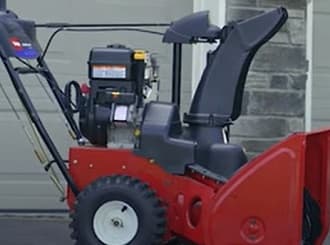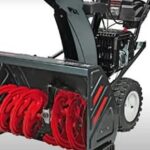As an Amazon Associate, this site earns commissions from qualifying purchases. For more information click here.
Does your snow blower sometimes push snow instead of throwing it? The machine starts okay but instead of throwing snow from the chute, it does not. Could this indicate a serious problem? While there is indeed something wrong with your snow blower, it can be fixed quite easily. This article shows you how.
If your snow blower is pushing snow instead of throwing it, this is probably due to broken shear pins, a worn out auger or clogged chute. An under powered snow blower is another reason, as wet snow is 2-3 times heavier than dry.
A Blocked Chute
After the auger shreds the snow, it is disposed of through the chute. At least that is how it is supposed to work. If the chute is clogged, it won’t be able to accommodate any more material.
To fix this problem, shut the snow blower off and look into the chute. Chances are it is stuffed with snow and ice. Ice in particular is troublesome because it blocks the chute quickly.
Remove the snow and clear the chute. If there is a lot of hard ice, use an ice scraper tool. After clearing the chute, spray it with an ice snow repellent to prevent buildup. A good choice is Snow Wax because it acts quickly and effectively.
It is important to also lubricate all the moving parts of a snow blower. Do this not only during winter but even for the rest of the year. This ensures the machine will be ready when you need it. If you don’t lubricate it regularly, these components will rust and wear out.

Snow Blower Lacks Power
If you are trying to clear wet snow, your snow blower probably lacks power. Wet snow is heavier than dry and demands more from the machine. If the chute is clear and the rest of the machine is well-maintained, it means the snow blower just doesn’t have enough power.
The solution is to buy a more powerful snow blower. The Snow Joe SJ627E Snow Blower is our top pick because it combines power with ease of use. With this machine you can handle wet and dry snow without problems.
If you do not want to upgrade yet, you can still use a low powered snow blower. However you need to move slowly. Reduce the amount of snow the blower takes in because it will lead to clogging.
It might also help to increase the speed. Of course you need to be careful so exercise caution as you go about this. If you want to clear more snow and faster, you have to get a more powerful model.
There are many types of snow blowers, but they are generally classified by stages: single, dual and triple (1, 2 and 3).
A single stage snow blower is for light snow. A 2 and 3 stage snow blower is more suitable for heavy snow. When it comes to wet snow, you are better off with a 2 or 3 stage blower. There are however, some single stage snow blowers that can handle heavy stuff too.
Worn Out Auger Blade
The auger is responsible for cutting snow into manageable chunks for the machine. Through constant use, the apparatus eventually gets worn out or dulls.
A worn out auger is no longer going to work like it should. If it fails to turn properly you will see it push snow instead of throwing it away.
It takes a lot to wear out an auger, but if you clear lots of wet snow, this can happen quickly. This is more likely to affect an under powered snow blower, so keep that in mind. It also depends on what kind of snow you deal with. If it is mostly dry snow, the auger will last longer. If it is wet or icy snow, it wears out faster.
An auger blade needs to be oiled regularly. Check your owner’s manual for how often it should be oiled. This video shows you how to do this.
Damaged Gear Box
If you have a 2-stage snow blower, the gearbox supplies power to the auger. It does so by engaging the auger belt which sets off the rest of the mechanism. If the gearbox is not working, the transmission is probably broken.
If your snow blower keeps pushing snow, make sure the gearbox has sufficient oil. Add more if needed, but also look out for leaks. This can happen if there is too much oil or damage. Any metallic element in the oil means you have a damaged gearbox. A broken gearbox has to be replaced.
Gear boxes are comprised of multiple gears. If there is only light damage, you might only need to get a new gear. But for heavy damage, it is better to get a new gearbox.
Broken Shear Pins
The shear pins link the auger to its drive mechanism. If these pins break off, the auger will stop working. Clogging is the most common cause but wear and tear is another reason.
The most obvious sign of broken shear pins is when the auger stops working. To be more specific, when the auger stops just when you try to clear snow.
To find the shear pins, grab the belt and rotate the auger. You should see two holes where the shear pins are. If the auger is moving freely with the blower turned off, the shear pins have been damaged.
Consult your owner’s manual for the type of shear pin required. The replacement has to be exactly the same. Using a different pin can damage the auger, the engine or both.
Once you find an exact match, install it. The process varies depending on the snow blower so you have to check your owner’s manual. Once installed, try the snow blower.
Lack of Maintenance
If your snow blower is in good condition, you can run it for as long as necessary. As this article explains, you don’t have to worry about overheating too much.
Regular maintenance is the key to making snow blowers last longer. Clean the chute, blades, tires and the rest of the machine after each use. When you are done, store the blower in your garage. If you have to leave the machine outdoors, cover it with a canvas.
Check the parts regularly for signs of wear and tear. The drive belt and auger are the most likely to affect its throwing so check those first. While you are at it, inspect the rest of the engine as well.
As winter ends, prepare your snow blower for storage. To prevent fuel from turning into a gummy substance, either empty the fuel tank or put fuel stabilizer in it. Which you pick is a matter of personal preference, but most prefer to empty the fuel tank.
How to Keep Your Snow Blower in Good Condition
First and foremost, read the owner’s manual. Follow the instructions and use, store and maintain only as directed.
Do not use your snow blower for anything other than its intended function. Otherwise you risk voiding the warranty and cause possible damage.
Have reserve parts available. Keep spare spark plugs, gears, shear pins etc. You don’t need to buy replacements for each part, only those most likely to break. This is not extra expense, but is actually a time and money saver.
Imagine if your snow blower breaks down in the middle of winter. There is a lot of snow and going to the hardware store is difficult, and they might be closed. Power is intermittent so ordering online is hard as well. If you have spare parts, you can rest easy.
Learn the most common causes of snow blower clogging. They will most likely be the reasons why it is pushing snow rather than throwing them. As shown here, a bit of knowledge is all it takes to fix a lot of these problems.

I love the outdoors and all the tools for maintaining gardens, yards and lawns. The only thing I am more passionate about is sharing what I know about garden and outdoor equipment.


